|
Second Atomic Bomb
Nagasaki
And
I Was There Within Months!
By
Milton Dienes
|
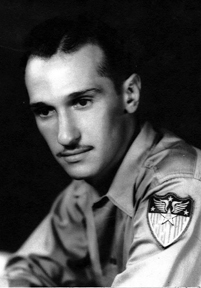
Milt
Dienes — 20th Air Force Strategic Air Command Photo Recon and
Intelligence — September 1945
Click image for larger viiew |
|
"Editor's
note: This is are a rare glimpse into the life and work of a
renown combat photographer from the Pacific war in WWII. His
work is already in the Library of Congress and is printed in
many prestigious publications.
Even at 95, Milton is alert and still using his considerable
skills.
Little did he realize while walking the streets of Nagasaki
just months after the world's second atomic bomb that his images
would one day be featured in the Library of Congress.
Like so many young men at that time, Milton was snatched from
Pennsylvania State University before he could finish his pre-med
degree BUT the world has been rewarded with his extraordinary
talent and Milt with a life well lived.
|
In recent editions of the King of Prussia
Courier and other area papers, there have been numerous articles
written about those in the services during World War II and the
individual stories of the various men involved.
With the August
2019 approaching and, with it, the anniversary of the first Atomic
Bombs being used at Hiroshima (8/6/45) and Nagasaki ((8/9/45), I
believe that I personally experienced a moment in history. this
experience is both interesting and newsworthy which would certainly
be of interest to your readers. This is a synopsis of personal experiences
while on Guam from 1945 to 1946 and the dropping of the Hiroshima
and Nagasaki Atomic Bombs. I have also included some personal information
and history of my background.
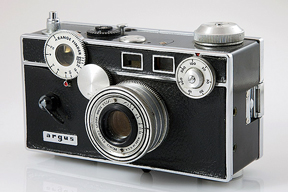 Argus C-3 35mm camera
Argus C-3 35mm camera
Click image for larger viiew |
At the age of 13, I was given
an Argus C-3 for my birthday which was the introduction to my
life of Photography. Some years later I was one of the Photo Editors
of the Central High School Yearbook in Philadelphia. Moving on
to Staff Photographer at Penn State.
At Penn State, I was in the School
of Chemistry and Physics which was the basis for pre-med. While
at Penn State I joined the Enlisted Reserve which would, supposedly,
allow the Class to finish pre-med. On May 15th, 1944, our reserve
was called out at the end of my sophomore year. We were told to
go home and await further orders. Several months later orders
came through and I ended up at Ft. McClellan, Alabama
for Basic Training, ending up as an 81mm Mortar Gunner |
in the 75th Division stationed at Camp
Breckinridge, Kentucky. While there I applied for Air Corp OCS (Officer's
Candidate School) in the Photographic Squadron in Denver, CO. While
I did not get into OCS, I was now a part of the Air Corp assigned
to Keesler Field in Biloxi MS and then on to Will Rodgers Field
in Oklahoma as part of the 9th Photo Squadron.
The 9th Photo Tech Squadron shipped to Harmon Field on
Guam where we set up the largest Photo outfit in the Pacific.
Our job was supplying photographs taken by Fighter and Bomber
pilots on their various missions. This was a part of the
20th Air Corp Reconnaissance and Intelligence Squadron Task
Force. At the peak, we processed and printed 14,000 photos
per day.
On August 6th and 7th we were given film from a bombing
run targeting Hiroshima, the city that was devastated by
the world's first Atomic Bomb. The negatives were difficult
to print because they were fogged by the radiation but the
famous "Mushroom" image was saved and produced.
Then on the 9th, four days later, the Nagasaki Bomb, dropped
by B-29 Bockscar, destroyed and devastated much of the City.
It is estimated that 120,00 were killed by the "Enola
Gay" and 70,000 by Bockscar in the bombings. Meanwhile,
back on Guam we were very busy processing and printing thousands
of prints. When I saw something very interesting I would
print a duplicate for myself.
About 100 days after the end
of the conflict, I was included in a small group of Photographers
sent to photograph Nagasaki, focusing on the tremendous
damage to urban life. We took many ground photos of factories,
office buildings, homes, railroad stations, landscapes and,
in my case, a small number of people. Many were not in good
shape from the radiation.
We spent a little short of
two days in Nagasaki, sleeping on the plane. Some of the
ground photos I personally took were also duplicated for
my own personal collection.
|
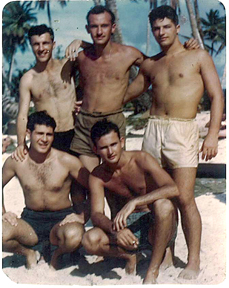
The 9th Photo Tech Squadron shipped to Harmon Field on Guam
where the five of us on Guam. Picture
taken New Years Day 1946.
Back row - left to right - Morton Krouse, ME, Dr. Irv Arno,Captain
Front row - Marvin Inselman, Unknown
Click image for larger viiew
|
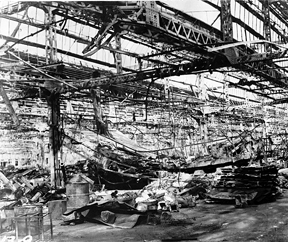 NAGASAKI FACTORY SHOWING TWISTED STEEL
DESTRUCTION FROM BOMBING - 1945
NAGASAKI FACTORY SHOWING TWISTED STEEL
DESTRUCTION FROM BOMBING - 1945
Click image for larger viiew |
I headed back to the States in March 1946 taking
50 photos with me that I had collected. Little did I know
how important they would become - Not to my knowledge at the
time. I much later found out when the 9th Photo Tech returned
to the States in November of '46 and was deactivated. All
the Photos, files, and equipment that was supposed to be shipped
back, actually was thrown away on Guam. No record of what
the 9th Photo Tech did while on Guam.
Fast forward to mid-August
2016. One afternoon my phone rang. It was Colonel Dianne Hickey,
Commander of the 14th Intelligence Squadron based At Wright-Patterson
Air Force Base in Dayton, Ohio. She wanted to know was I Milton
Dienes(Yes). Was I on Guam (Yes ). Was I a part of the 9th
Photo Tech Squadron (Yes). She had been looking for me or
any one of the 100 squad members and was only able to locate
one other, Jerry Johnson. We spoke for over one hour which
lead to an invitation for both of us to be feted and Honored
for three days at Wright-Patterson AFB in the latter part
of September 23rd to 25th. They really rolled out the red
Carpet for us. We spent most of the time being interviewed,
audio recorded
|
and videotaped about every detail we could remember. The
entire Squadron of 200 greeted us with a standing ovation.
They asked so many questions, asking Jerry and me to recall
every detail we could remember. Saturday afternoon they
held a Picnic and every Squadron wore a Photo Tech Squadron
T-shirt like they saw me wearing while on Guam. The last
day we visited the HUGE Air Force Museum that houses almost
every type of aircraft both domestic and foreign military.
One of the last photos taken was of the Colonel, Jerry and
Myself with a small group of squadron members, who came
to see us off, in front of the B-29 Bockscar. Needless to
say, I personally took over 200 photos of the whole proceedings
Not mentioned above, but most
important of all! The original photos taken by Jerry and
myself while on Guam were copied and my originals were taken
home. The Nagasaki photos that I saved are the only photos
that exist. All my 50 photos are now in The Library of Congress,
The National Archives
|
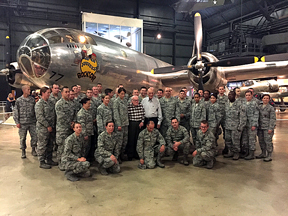
B
29 BOCKSCAR, THE PLANE THAT DROPPED THE ATOMIC BOMB ON NAGASAKI
AUGUST 9, 1945 WITH COLONEL DIANNE HICKEY, JERRY JOHNSON AND
MILT DIENES AND SQUADRON MEMBERS AT THE AIR FORCE MUSEUM IN
GAYTON, OHIO
Click image for larger viiew
|
and the Air Force Archives.
When I returned home from WP AFB I made
a PowerPoint Presentation of the ORIGINAL photographs which I have
been using to tell my story at so many locations. I have received
calls or emails inviting me for a "show and Tell" of my
NAGASAKI BOMB DROP story. My next Presentation is Scheduled for
the end of July 2019 at THE FREEDOMS FOUNDATION just outside of
Valley Forge National Park.
There are a number of Videotapes that
you might like to see. They can be viewed by putting MILTON DIENES-PHOTOGRAPHER
in your browser's search bar. You may find them educational and
interesting.
Photo
Gallery
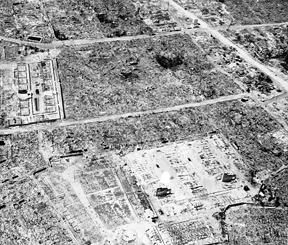
NAGASAKI 1945 AFTER ATOMIC BOMB DROPPED BY B-29 BOCKSCAR
TOTALLY DESTROYING
LANDSCAPE OTHER THAN FEW NEWER BUILDINGS
Click image for larger viiew |
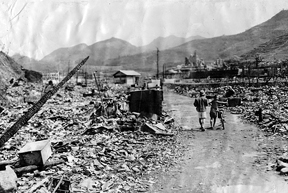
NAGASAKI
- WALKING THROUGH THE RUBBLE CREATED BY B-29 BOCKSCAR 100 DAYS
AFTER THE BOMBING -1945
Click image for larger viiew
|
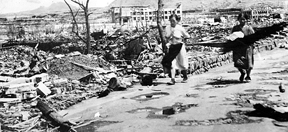 NAGASAKI 1945- WALKING ALONG A ROAD 100
DAYS AFTER THE BOMBING - NOTE RUBBLE IN FOREGROUND AND NEWER
BUILDINGS IN THE DISTANCE
NAGASAKI 1945- WALKING ALONG A ROAD 100
DAYS AFTER THE BOMBING - NOTE RUBBLE IN FOREGROUND AND NEWER
BUILDINGS IN THE DISTANCE
Click image for larger viiew |
|